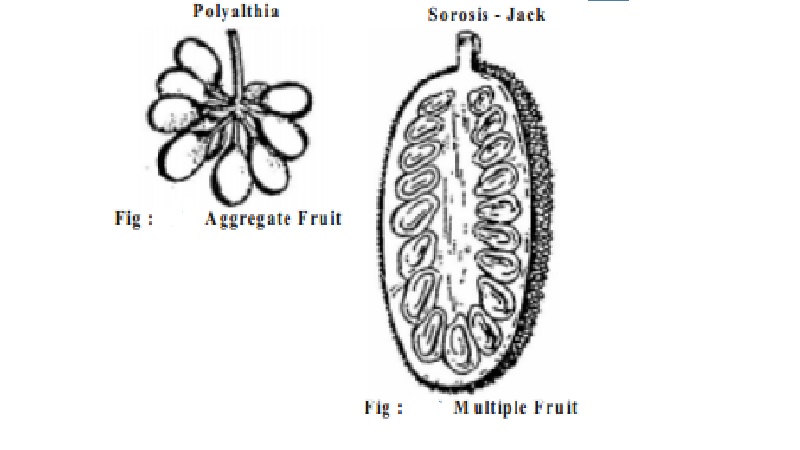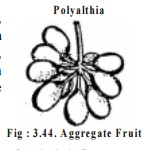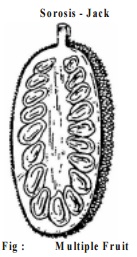Chapter: 11 th 12th std standard Bio Botany plant tree Biology Higher secondary school College Notes
aggregate and multiple or composite fruits

A fruit consists of two main parts - the seeds and the pericarp or fruit wall. The structure and thickness of pericarp varies from fruit to fruit. The pericarp consists of three layers - outer epicarp, middle mesocarp and inner endocarp. The sweet juicy and edible flesh is the mesocarp, the inner most hard covering is the endocarp. These three layers are not easily distinguishable in dry fruits.
The fruits are usually classified into three groups, namely simple, aggregate and multiple or composite fruits.
Aggregate fruit

An aggregate fruit develops from a single flower, with multicarpellary, apocarpous, superior ovaries and each of them develops into simple fruitlets. An aggregate fruit, therefore consists of a collection of simple fruits as in Polyalthia. The carpels of the flower unite and give rise to a single fruit as in annona squamosa.
Multiple or Composite Fruit

Multiple or composite fruit is formed by all the flowers of a whole inflorescence grouped together to give a single big fruit. In a sense, multiple fruits are false fruits.
In Jack, the type of multiple fruit is sorosis. The rachis and all the floral parts of the female inflorescence fuse together forming composite fruit. The inflorescence axis and the flowers all become fleshy.
In the centre of the fruit, there is a club-shaped, thick, fleshy central axis, which is the inflorescence axis. The edible part of the fruit represents the perianth, which is fleshy and juicy. The pericarp is bag-like and contains one seed. The spines on the tough rind represent the stigmas of the carpel. The sterile or unfertilized flowers, occur in the form of numerous, elongated, whitish, flat structures in between the edible flakes.
Sorosis: A multiple fruit that develops from a spicateinflorescence. eg. Ananas sativus (Pineapple).
Pineapple plant is largely cultivated for its fruits. The stem is short and leafy and bears a terminal spicate inflorescence. After fertilization, the axis and the flowers, along with the bracts, become stimulated to grow and unite together into a fleshy compound fruit, the 'Pineapple'. On the surface of the fruit, the hexagonal areas represent the flowers, and the tips of the floral bracts project out. Usually the flowers are sterile and seeds are rarely formed. The inflorescence axis produces a tuft of vegetative leaves, which forms a crown at the top. The vegetative top, if cut and planted, establishes itself in the ground and gives rise to a new plant.
Related Topics